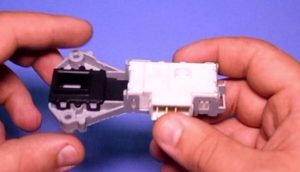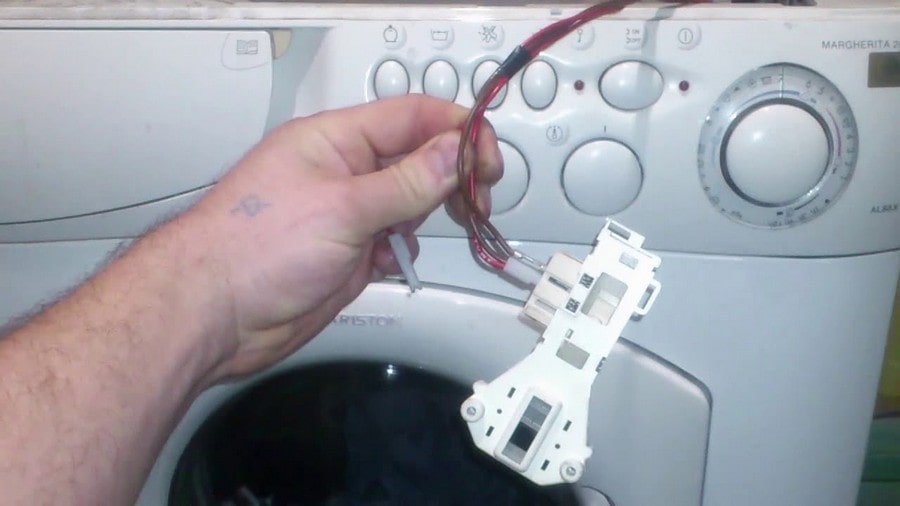 All modern washing machines are equipped with hatch locking devices or, in short, UBL. During washing, it locks the door and thereby ensures safety. If this unit is broken, the machine will not start the wash or will not unlock the door at the end of the program. You can repair it yourself if you know how to check the lock of a washing machine.
All modern washing machines are equipped with hatch locking devices or, in short, UBL. During washing, it locks the door and thereby ensures safety. If this unit is broken, the machine will not start the wash or will not unlock the door at the end of the program. You can repair it yourself if you know how to check the lock of a washing machine.
Operating principle and types of locks
Today, two types of locks are commonly found:
- Electromagnetic.
- Bimetallic.
The first type is used less and less. Its main drawback is that the lock only works properly as long as there is electricity. If the light is turned off, the washing machine will not be unlocked.
The operating principle of a bimetallic lock is very simple: voltage is applied to the thermal element and heats it up. The hot thermocouple heats up the bimetallic plates; under the influence of heat, they expand and press on the lever. It goes off and blocks the door. At the end of the program, the voltage supply to the lock stops, the plates cool down, narrow and the latch returns to its original place. The washing machine hatch is unlocked.
The second type of locks has a number of advantages. Firstly, there is a delay in unlocking the hatch at the end of the program. This is necessary so that the washing machine completely drains the water and all its elements complete their work.Secondly, even if the power goes out, the lock will unlock, and the door can be opened and the laundry taken out. This type of UBL is used by many modern manufacturers of washing machines - LG, Samsung, Indesit, etc.
Reasons for lock failure
There are several reasons why the door lock of a washing machine breaks.
- Firstly, this is the wear of bimetal plates as a result of prolonged use of the equipment. As a result of regular deformation, their functional properties are lost.
- Secondly, the reason may be a short circuit.
In some cases, the problem may not be with the UBL. If the washing machine has finished working, but the door does not open, the triacistor on the central board responsible for the operation of the lock may be faulty. In this case, voltage continues to flow to the locking device and as a result the door remains locked.
Symptoms of a problem

The owner of a washing machine can determine if the lock is broken by the following signs:
- The equipment completed its work and turned off, but the hatch was still blocked. This indicates a malfunction of the UBL or central module.
- After selecting and turning on the mode, the door does not lock and the washing machine does not start the program.
- The washing machine displays a code or reports a UBL malfunction by flashing indicators in a certain sequence.
You can determine what the cause of the breakdown is using a multimeter.
Diagnostics and repair of the lock on your own

To check the serviceability of the lock, it will need to be removed. Necessary:
- Unplug the washing machine.
- Open the hatch, bend the cuff, pry up the clamp and remove it.
- Pull the cuff to the side to gain access to the lock.
- Unscrew the fasteners securing the device.
- Disconnect the wiring and pull out the UBL.
This method is suitable if the door opens. Otherwise, you need to open the base panel on the front of the washing machine and find the emergency cable for opening the hatch. It is usually yellow or red and is located near the filter. If there is no cable, you need to unscrew the fasteners holding the top cover, remove it, and then put your hand between the body and the tank, find the lock latch by touch and unlock it. Now you can open the door and begin removing the UBL.
Now you can start checking the blocker using a multimeter. To determine where the neutral and common contacts are located, you will need a diagram of the lock. Hatch locking devices are produced by various companies that arrange the contacts in their own way. Without knowing the diagram, it is impossible to understand the contacts and diagnose the lock. You can find the diagram on the Internet.
At home, you can only check the thermoelement that heats the plates. To do this you need:
- Set up the multimeter to measure resistance.
- Find the neutral and phase contacts and install probes on them.
- If a three-digit number appears on the tester display, this indicates that the blocker is working.
- Now you need to move the probes to the neutral and common contacts.
- If one or zero appears on the screen, the device is broken.
If the blocker is working properly, you need to inspect it for mechanical damage or manufacturing defects.
To replace, you need to purchase a new lock. This can be done at the manufacturer's service center, in a specialized store or via the Internet.To avoid mistakes when purchasing a part, you need to tell the seller the make and model of the washing machine.
Installing the hatch lock is performed in the following order:
- Connect the wiring to the UBL.
- Place the lock inside the washing machine and insert it into the seat.
- Screw in the fastener.
- Return the cuff to its original place and install the clamp.
If after replacing the UBL the problems continue, this indicates a malfunction of the system board. It is not recommended to repair it yourself, because it can only worsen the situation. To diagnose and repair the breakdown, you should contact a service center or call a professional.
Some washing machine owners are interested in whether it is possible to bypass the lock and start washing. Theoretically, there is such a possibility, but in this case, everyone who has access to the technology will be at risk of electric shock. Also, if you open the unlocked door during washing, there is a risk of being scalded by hot water. It is for these reasons that it is recommended to carry out repairs and replace a part that is inexpensive, rather than searching for a way to bypass the blocking.
Conclusion
If after washing the hatch of the washing machine does not open or, conversely, the equipment does not start the program because the door is not locked, the most likely cause of the malfunction is the failure of the hatch locking device (UBL). You can check the door lock and replace it with a new one, if it is really broken, on your own at home, the main thing is to purchase a new part and be able to work with a multimeter.Bypassing the protection and attempting to turn on the washing machine with the door unlocked is prohibited, because such actions can cause significant harm to the health of everyone who has access to the washing machine. similar entries from this section









